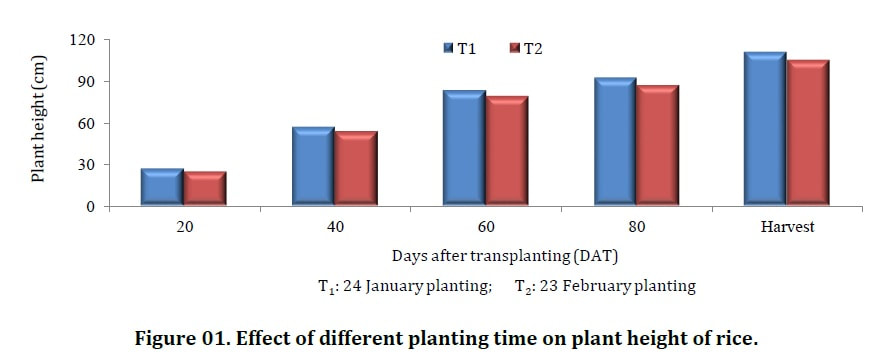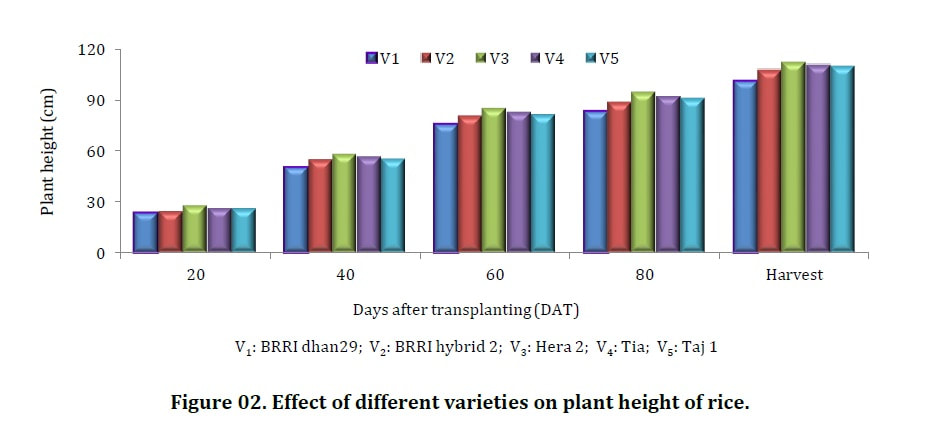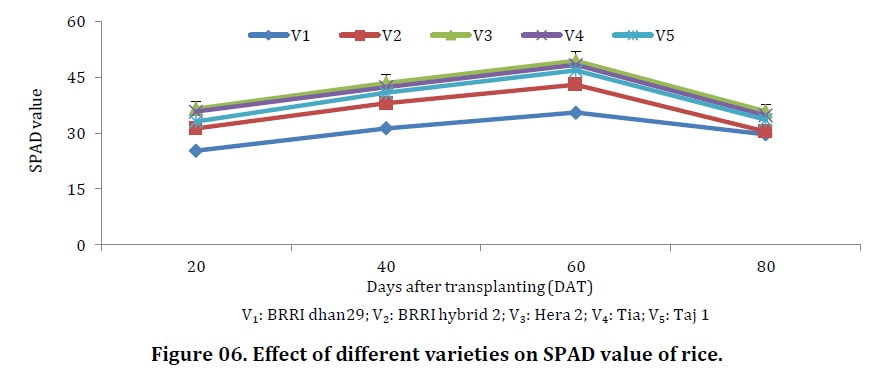J. Biosci. Agric. Res. | Volume 19, Issue 02, 1613-1627| https://doi.org/10.18801/jbar.190219.196
Article type: Research article, Received: 10.12.2018, Revised: 20.02.2019, Date of Publication: 14 March 2019.
Article type: Research article, Received: 10.12.2018, Revised: 20.02.2019, Date of Publication: 14 March 2019.
Morpho-physiological characters and shoot reserve remobilization of rice under different planting dates
Naznin Ahmed, Kamal Uddin Ahamed, Nasima Akhter, Md. Tofail Hosain, Rezowana Nizam and Md. Saidur Rahman
Department of Agricultural Botany, Sher-e-Bangla Agricultural University, Dhaka-1207, Bangladesh.
Department of Agricultural Botany, Sher-e-Bangla Agricultural University, Dhaka-1207, Bangladesh.
Abstract
The actual planting date gives the best morpho-physiological characters and highest shoot reserve translocation which finally increased the rice yield. The experiment comprised of two factors- factor a: Planting time (2): T1: 24 January planting; T2: 23 February planting and factor b: Rice variety (5): V1: BRRI dhan29; V2: BRRI hybrid 2; V3: Hera 2; V4: Tia and V5: Taj 1. The experiment was laid out in a randomized complete block design (RCBD) with three replications. Among the different planting time and varieties, 24 January planting and Hera 2 were found superior in terms of morpho-physiological characters and shoot reserve remobilization of rice cultivars. Irrespective of planting times, the highest plant height (112.03 cm), tillers hill-1 (16.43), SPAD value of leaves (35.82), and leaf area index (5.74) were achieved. Hera 2 provided the highest shoot reserve translocation (17.83% and 15.84%) at 24 January planting and 23 February planting, respectively compared to other rice varieties. Finally, 24 January transplanting with Hera 2 exhibited the superior combinations than other parameters.
Keywords: Rice, Planting date and Shoot reserve remobilization
The actual planting date gives the best morpho-physiological characters and highest shoot reserve translocation which finally increased the rice yield. The experiment comprised of two factors- factor a: Planting time (2): T1: 24 January planting; T2: 23 February planting and factor b: Rice variety (5): V1: BRRI dhan29; V2: BRRI hybrid 2; V3: Hera 2; V4: Tia and V5: Taj 1. The experiment was laid out in a randomized complete block design (RCBD) with three replications. Among the different planting time and varieties, 24 January planting and Hera 2 were found superior in terms of morpho-physiological characters and shoot reserve remobilization of rice cultivars. Irrespective of planting times, the highest plant height (112.03 cm), tillers hill-1 (16.43), SPAD value of leaves (35.82), and leaf area index (5.74) were achieved. Hera 2 provided the highest shoot reserve translocation (17.83% and 15.84%) at 24 January planting and 23 February planting, respectively compared to other rice varieties. Finally, 24 January transplanting with Hera 2 exhibited the superior combinations than other parameters.
Keywords: Rice, Planting date and Shoot reserve remobilization
Article Full-Text PDF
| 196.02.19.2019_morpho-physiological_characters_and_shoot_reserve_remobilization_of_rice_under_different_planting_dates.pdf | |
| File Size: | 1018 kb |
| File Type: | |
Article Metrics
|
Share This Article
|
|
Article Citations
MLA
Ahmed et al. “Morpho-physiological characters and shoot reserve remobilization of rice under different planting dates.” Journal of Bioscience and Agriculture Research 19(02) (2019): 1613-1627.
APA
Ahmed, N., Ahamed, K. U., Akhter, N., Hosain, M. T., Nizam, R. and Rahman, M. S. (2019). Morpho-physiological characters and shoot reserve remobilization of rice under different planting dates. Journal of Bioscience and Agriculture Research, 19(02), 1613-1627.
Chicago
Ahmed, N., Ahamed, K. U., Akhter, N., Hosain, M. T., Nizam, R. and Rahman, M. S. “Morpho-physiological characters and shoot reserve remobilization of rice under different planting dates.” Journal of Bioscience and Agriculture Research 19(02) (2019): 1613-1627.
Harvard
Ahmed, N., Ahamed, K. U., Akhter, N., Hosain, M. T., Nizam, R. and Rahman, M. S. 2019. Morpho-physiological characters and shoot reserve remobilization of rice under different planting dates. Journal of Bioscience and Agriculture Research, 19(02), pp. 1613-1627.
Vancouver
Ahmed, N, Ahamed, KU, Akhter, N, Hosain, MT, Nizam, R and Rahman, MS. Morpho-physiological characters and shoot reserve remobilization of rice under different planting dates. Journal of Bioscience and Agriculture Research. 2019 March 19(02): 1613-1627.
Ahmed et al. “Morpho-physiological characters and shoot reserve remobilization of rice under different planting dates.” Journal of Bioscience and Agriculture Research 19(02) (2019): 1613-1627.
APA
Ahmed, N., Ahamed, K. U., Akhter, N., Hosain, M. T., Nizam, R. and Rahman, M. S. (2019). Morpho-physiological characters and shoot reserve remobilization of rice under different planting dates. Journal of Bioscience and Agriculture Research, 19(02), 1613-1627.
Chicago
Ahmed, N., Ahamed, K. U., Akhter, N., Hosain, M. T., Nizam, R. and Rahman, M. S. “Morpho-physiological characters and shoot reserve remobilization of rice under different planting dates.” Journal of Bioscience and Agriculture Research 19(02) (2019): 1613-1627.
Harvard
Ahmed, N., Ahamed, K. U., Akhter, N., Hosain, M. T., Nizam, R. and Rahman, M. S. 2019. Morpho-physiological characters and shoot reserve remobilization of rice under different planting dates. Journal of Bioscience and Agriculture Research, 19(02), pp. 1613-1627.
Vancouver
Ahmed, N, Ahamed, KU, Akhter, N, Hosain, MT, Nizam, R and Rahman, MS. Morpho-physiological characters and shoot reserve remobilization of rice under different planting dates. Journal of Bioscience and Agriculture Research. 2019 March 19(02): 1613-1627.
References
- Akbar, M. K. (2004). Response of hybrid and inbred rice varieties to different seedlings ages under system of rice intensification in transplant aman season. M.S. (Ag.) Thesis, Dept. Agron. BAU, Mymensingh.
- Bhuiyan, M. S. H., Zahan, A., Khatun, H., Iqbal, M., Alam, F. and Manir, M. R. (2014). Yield performance of newly developed test crossed hybrid rice variety. International Journal of Agronomy and Agricultural Research, 5(4), 48-54.
- Bonnett, G. D. and Incoll, L. D. (1992). The potential pre-anthesis and post-anthesis contribution of stem internodes to grain yield in crop of winter barley. Annals of Botany, 69(3), 219-225. https://doi.org/10.1093/oxfordjournals.aob.a088333
- BRRI (2003). Annual internal review for 2003. Grain Quality and Nutrition Division. Bangladesh Rice Research Institute, Joydebpur, Gazipur, Bangladesh.
- BRRI. (2013). Adhunik dhaner chash (in Bengali). Bangladesh Rice Research Institute, Joydebpur, Gazipur.
- Castillo, A. G., Hampton, J. G. and Coolbear, P. (1994). Effect of sowing dates and harvest timing on seed vigor in garden pea (Pisum sativum L.). New Zealand Journal of Crop and Horticultural Science, 22, 91-95. https://doi.org/10.1080/01140671.1994.9513810
- Farrell, T. C., Fukai, S. and Williams, R. L. (2006). Minimizing cold damage during reproductive development among temperate rice genotypes. I. Avoiding low temperature with the use of appropriate sowing time and photoperiod-sensitive varieties. Australian Journal of Agricultural Research, 57(1), 75-88.
- Gangwar, K. S. and Sharma, S. K. (1997). Influence of planting dates on productivity of traditional scented rice varieties. IRRN, 22(1), 42.
- Gomez, K. A. and Gomez, A. A. (1984). Statistical procedure for agricultural research. International Rice Research Institute. John Wiley and Sons, New York, USA.
- Haque, M. M., Pramanik, H. R., Biswasm, J. K., Iftekharuddaula, K. M. and Hasanuzzaman, M. (2015). Comparative performance of hybrid and elite inbred rice varieties with respect to their source-sink relationship. Scientific World Journal, pp. 1-11.
- Hien, N. L., Yoshihashi, T. and Sarhadi, W. A. (2006). Evaluation of aroma in rice using KOH method, molecular markers and measurement of 2-acetyl-1-pyrroline concentration. Japanese Journal of Tropical Agriculture, 50, 190-198.
- Hossain, M. and Deb, U. K. (2003). Liberalization of rice sector: can Bangladesh withstand regional competition? Poster paper presented at PETRRA communication fair 2003 held at Hotel Sheraton, Dhaka, Bangladesh. https://doi.org/10.1016/S1672-6308(09)60033-0
- IRRI (International Rice Research Institute) (2013). Trend in global rice consumption. Rice Today, 12(1), 44-45.
- Islam, M. S., Bhuiya, M. S. U., Rahman, S. and Hussain, M. M. (2010). Evaluation of SPAD and LCc based nitrogen management in rice (Oryza sativa L.). Bangladesh Journal of Agricultural Research, 34(4), 661–672. https://doi.org/10.3329/bjar.v34i4.5841
- Jhoun, H. R. K. (1989). Effect of time of planting and age of seedling on growth and yield of dwarf rice. Indian Journal of Agronomy, 34, 325-327.
- Kainth, G. S. and Mehra, P. L. (1985). Rice production-potential and constraints. Inter-India Publications, New Delhi, India.
- Khalifa, A. A. B. A. (2009). Physiological evaluation of some hybrid rice varieties under different sowing dates. Australian Journal of Crop Science, 3(3), 178-183. http://www.cropj.com/khalifa_3_3_178.
- Khan, N., Oasim, M., Ahmed, F., Naz, F. and Khan, R. (2002). Effect of sowing dates on yield of maize under Agroclimatic condition of kaghan valley. Asian Journal of Plant Science, 1(2), 146-147. https://doi.org/10.3923/ajps.2002.146.147
- Kushwaha, U. K. S., Khatiwada, S. P. and Upreti, H. K. (2016). Delayed transplanting of aged rice seedlings causes the yield reduction in farmer's field. Genomic Applied Biology, 7(1),1-9.
- Masum, S. M., Ali, M. H. and Ullah, J. (2008). Growth and yield of two T. aman rice varieties as affected by seedling number per hill and urea supper granules. Journal of Agricultural Education and Technology, 11(1 and 2), 51-58. https://doi.org/10.5376/gab.2016.07.0001
- Momin, S. I. and Husain, M. (2009). Technology development and dissemination to augment rice production in Bangladesh. In: The Guardian.
- Munoz, D., Gutierrez, P. and Carredor, E. (1996). Current status of research and development of hybrid rice technology in Colombia. In. Abst., Proc. 3r Intl. Symp. On Hybrid Rice. Directorate Rice Research, Hyderabad, India.
- Nahar, K., Mirza, H. and Ratna, R. M. (2009). Effect of low temperature stress in transplanted aman rice varieties mediated by different transplanting dates. Academic Journal of Plant Science, 2(3), 132-138.
- Prakash, N. B. (2010). Different sources of silicon for rice farming in Karnataka. Paper presented in Indo-US workshop on silicon in agriculture, held at University of Agricultural Sciences, Bangalore, India.
- Sarkar, R. K. and Reddy, J. N. (2006). Response of lowland rice (Oryza sativa) cultivars to different sowing dates during rainy season. Indian Council of Agricultural Research. New Delhi, India.
- Shah, M. L. and Yadav, R. (2001). Response of rice varieties to age of seedlings and transplanting dates. Nepal Agriculture Research Journal, 4 & 5, 14-17.
- Soil Resource Development Institute (SRDI) (2012). Characteristics of experimental soil. Soil Resources Development Institute (SRDI), Khamarbari, Farmgate, Dhaka, Bangladesh.
- Siddique, M. N. A., Sultana, J., Sultana, N. and Hossain, M. (2007). Effect of planting dates on growth and flowering of Hippeastrum (Hippeastrum hybridum). Int. J. Sustain. Crop. Prod. 2(5), 12-14.
- Sultana, J., Siddique, M. N. A. and Abdullah, M. R. (2015). Fertilizer recommendation for agriculture: practice, practicalities and adaptation in Bangladesh and Netherlands. International Journal of Business, Management and Social Research, 1(1), 21-40. https://doi.org/10.18801/ijbmsr.010115.03
- Tang, W. B., Zhang, G. L., Xiao, Y. H., Deng, H. B., Fan, K., Liu, G. H. and Chen, L. Y. (2010). Physiological and biochemical characteristics in flag leave of the C Liangyou series of rice hybrid combinations at late growth stages. Rice Science, 17(4), 319–325.
- Vandana, J., Anis, G. S. B. and Mavi, H. S. (1994). Effect of different dates of transplanting on biomass of production and its partitioning in various parts of rice crop. Indian Journal of Ecology, 21(1), 13-18.
- Zaman, S. M. H. (1986). Current status and prospects for rainfed food grain production in Bangladesh. BRRI, Gazipur.
- Zhende, Y. (1988). Agronomic management of rice hybrids compared with conventional varieties. International Rice research Institute, Manila, Philippines.
© 2019 The Authors. This article is freely available for anyone to read, share, download, print, permitted for unrestricted use and build upon, provided that the original author(s) and publisher are given due credit. All Published articles are distributed under the Creative Commons Attribution 4.0 International License.
Journal of Bioscience and Agriculture Research EISSN 2312-7945.


